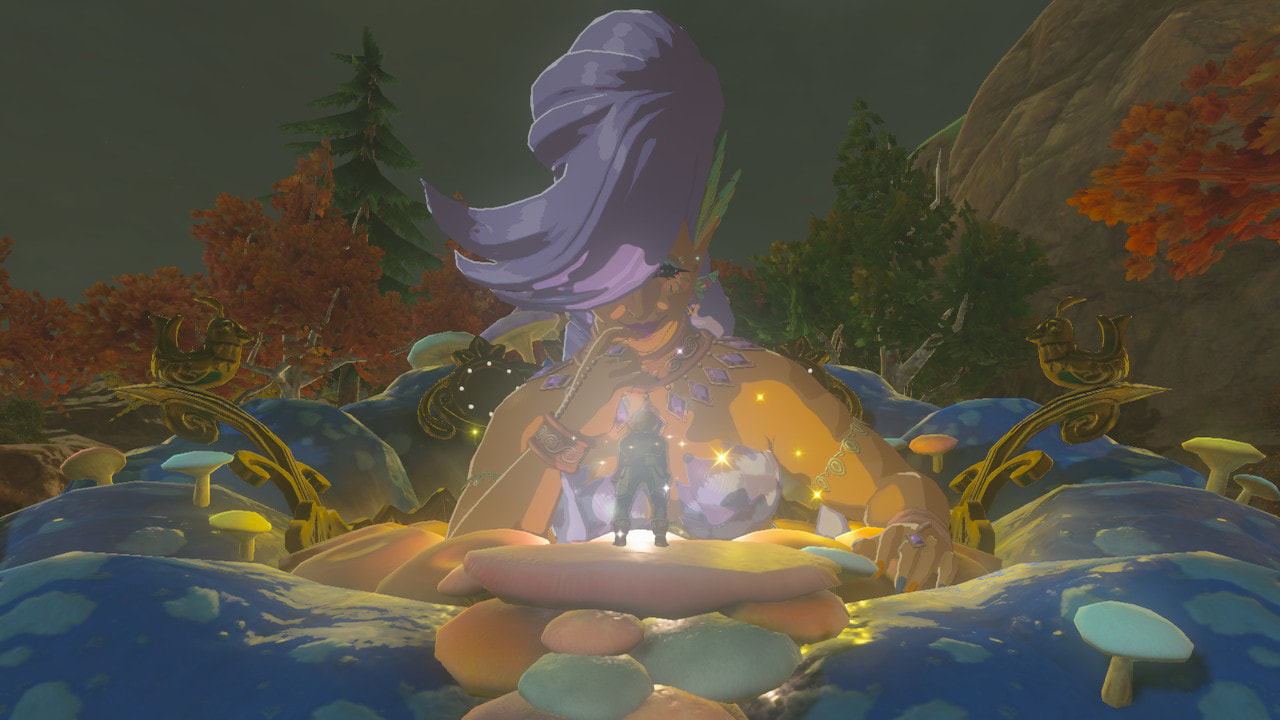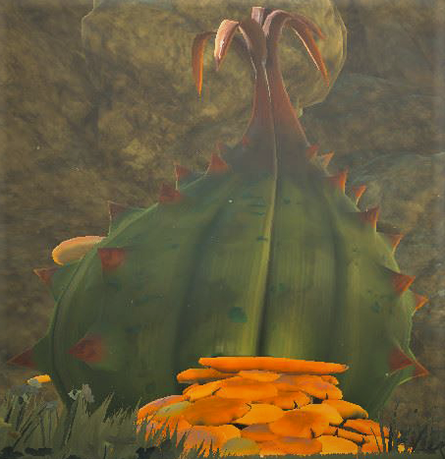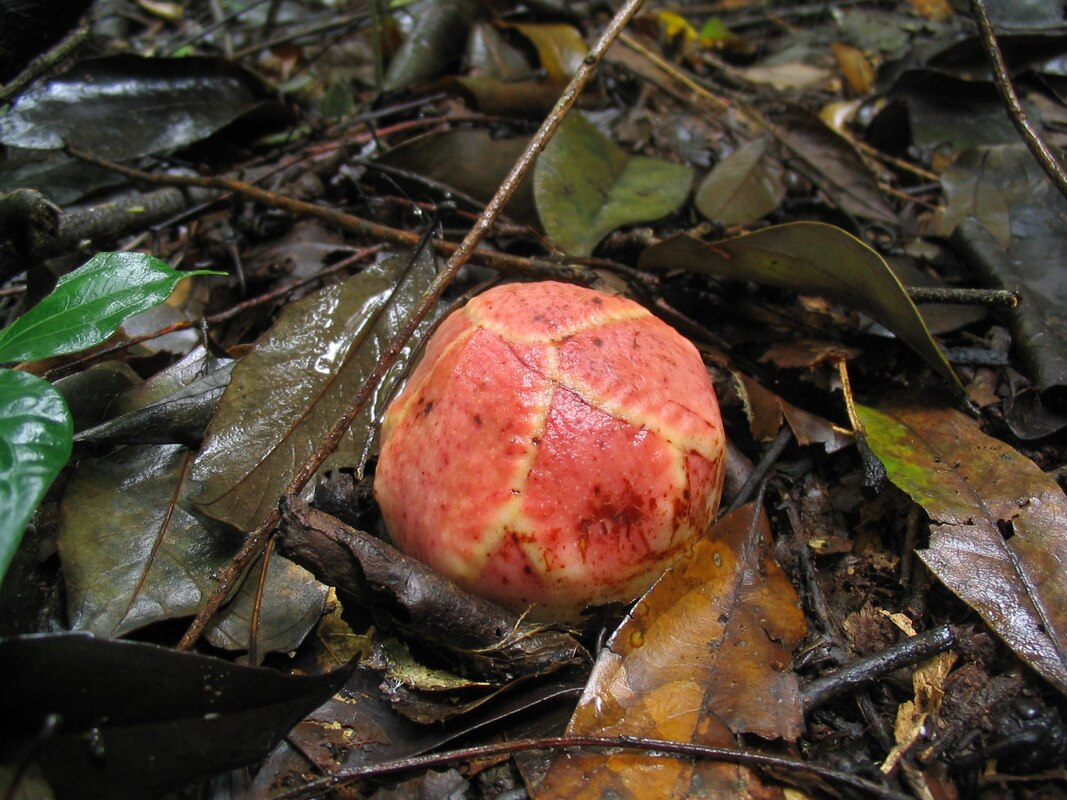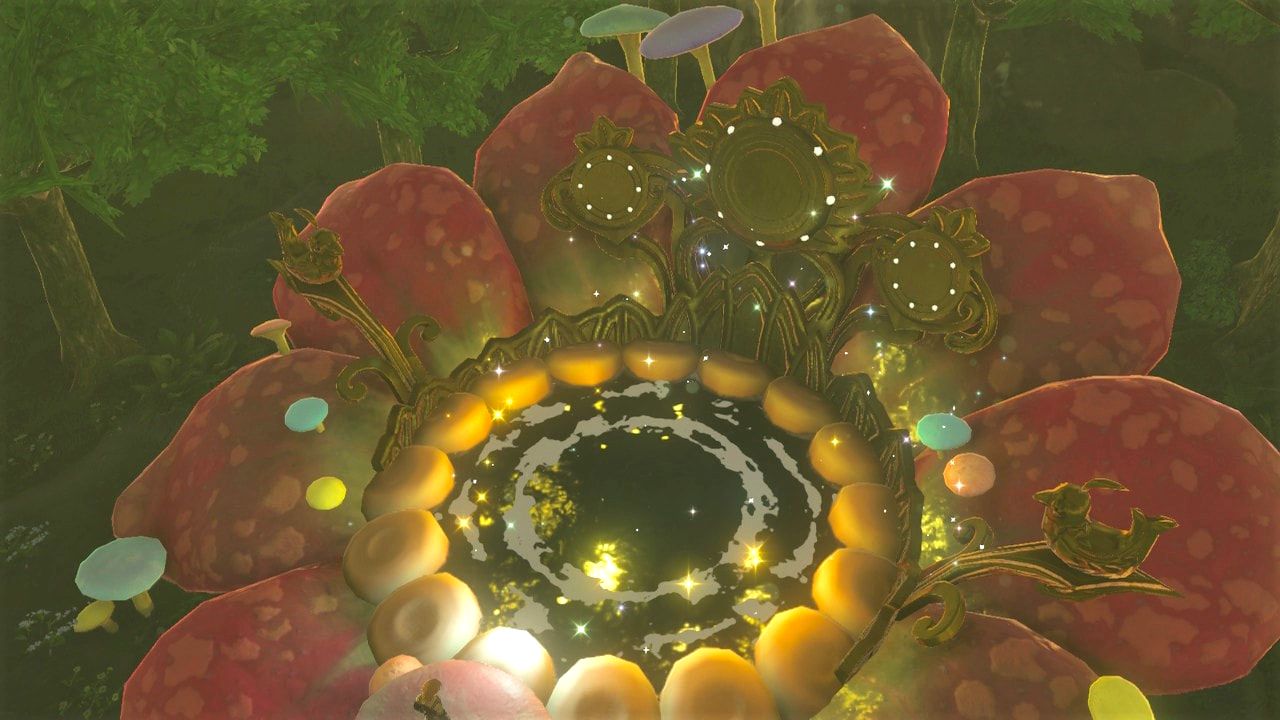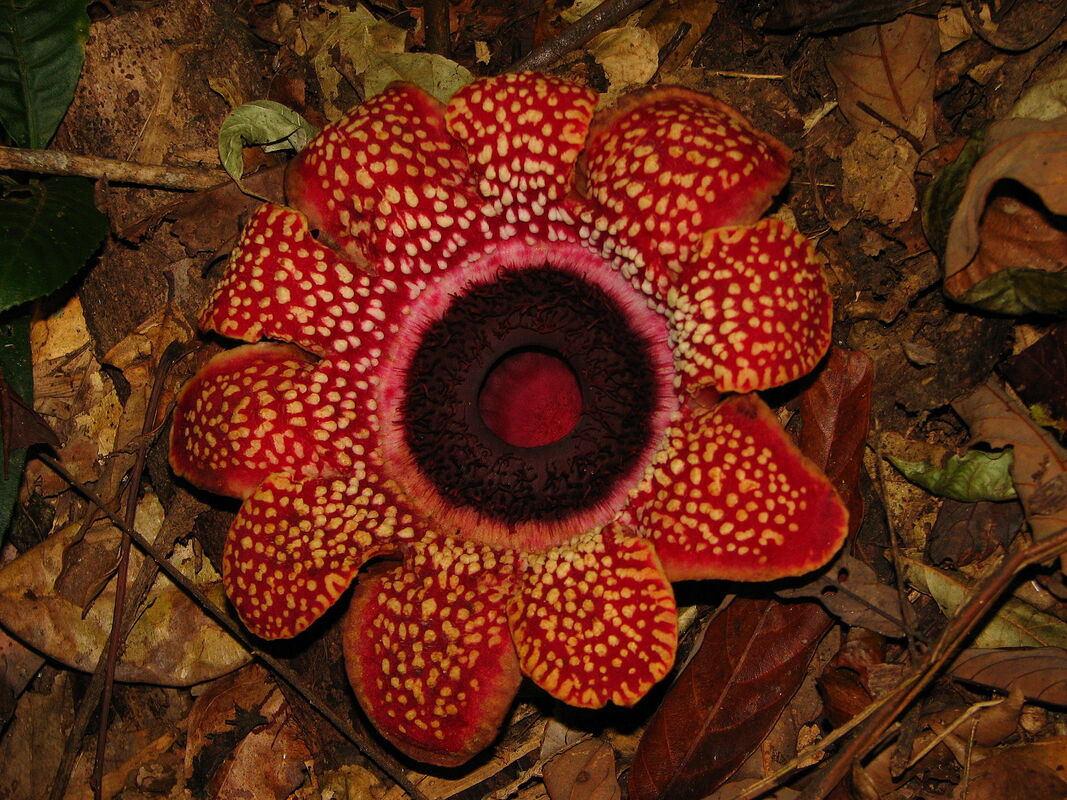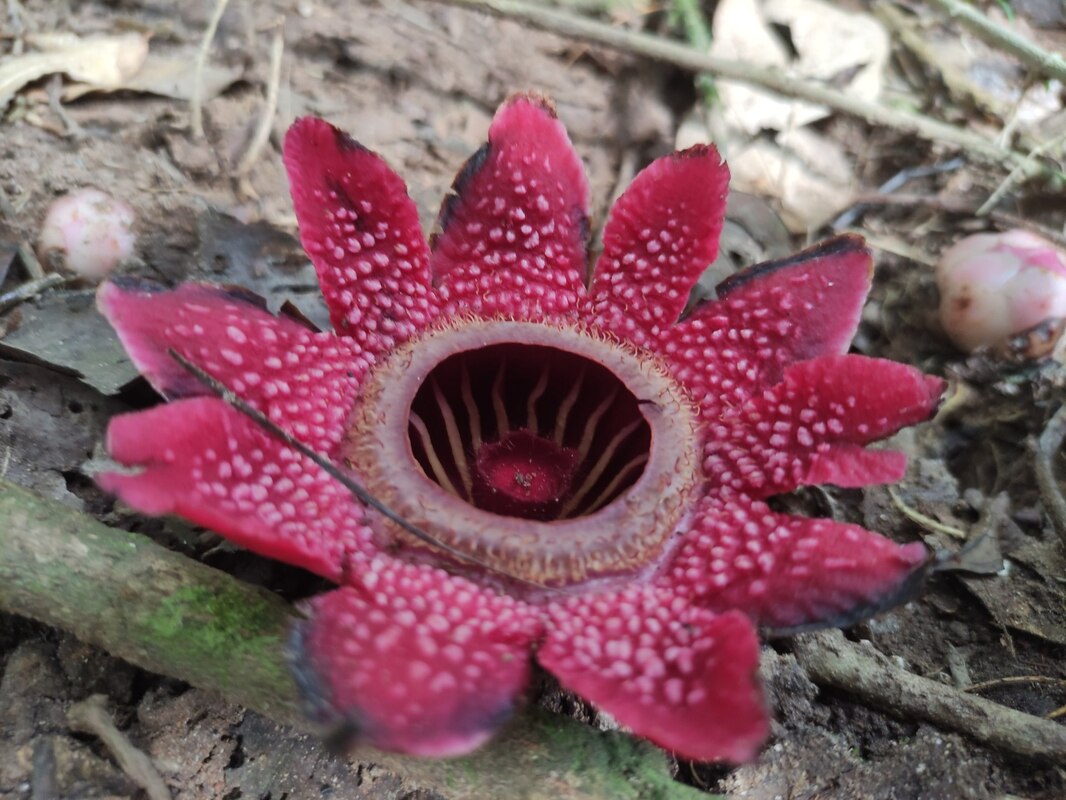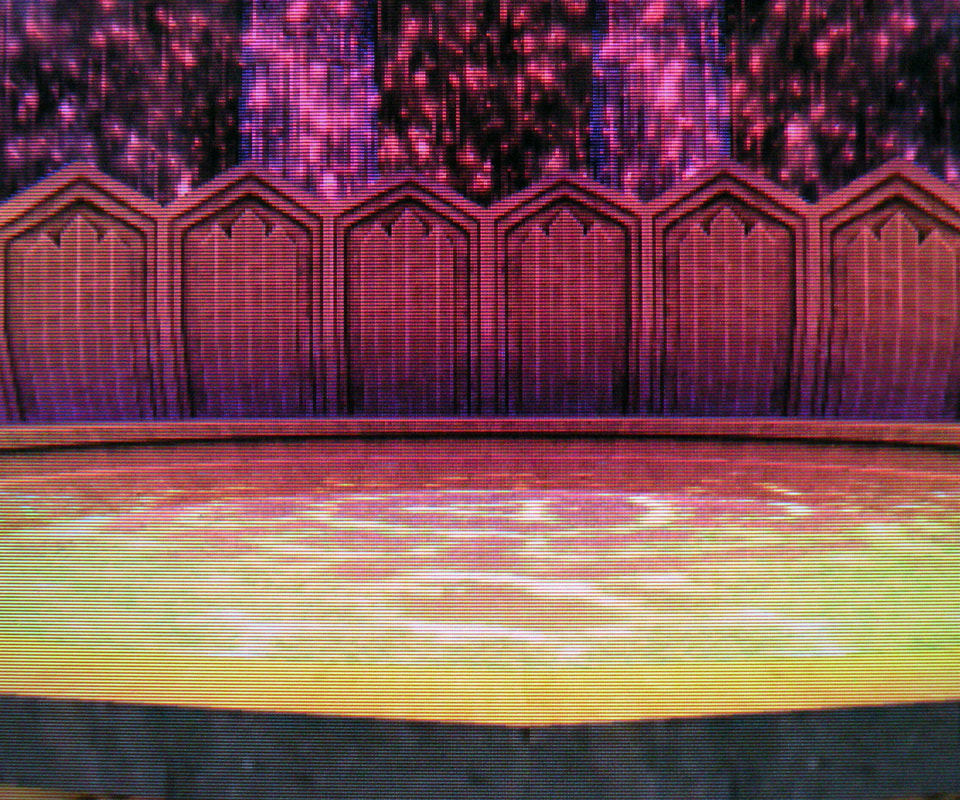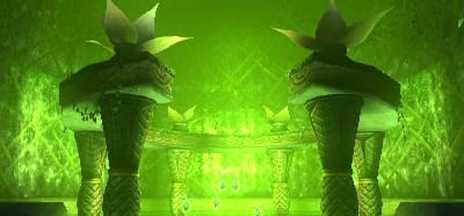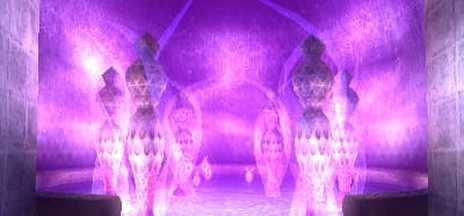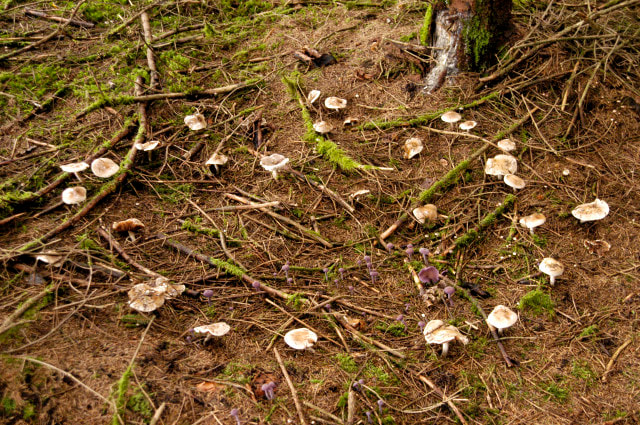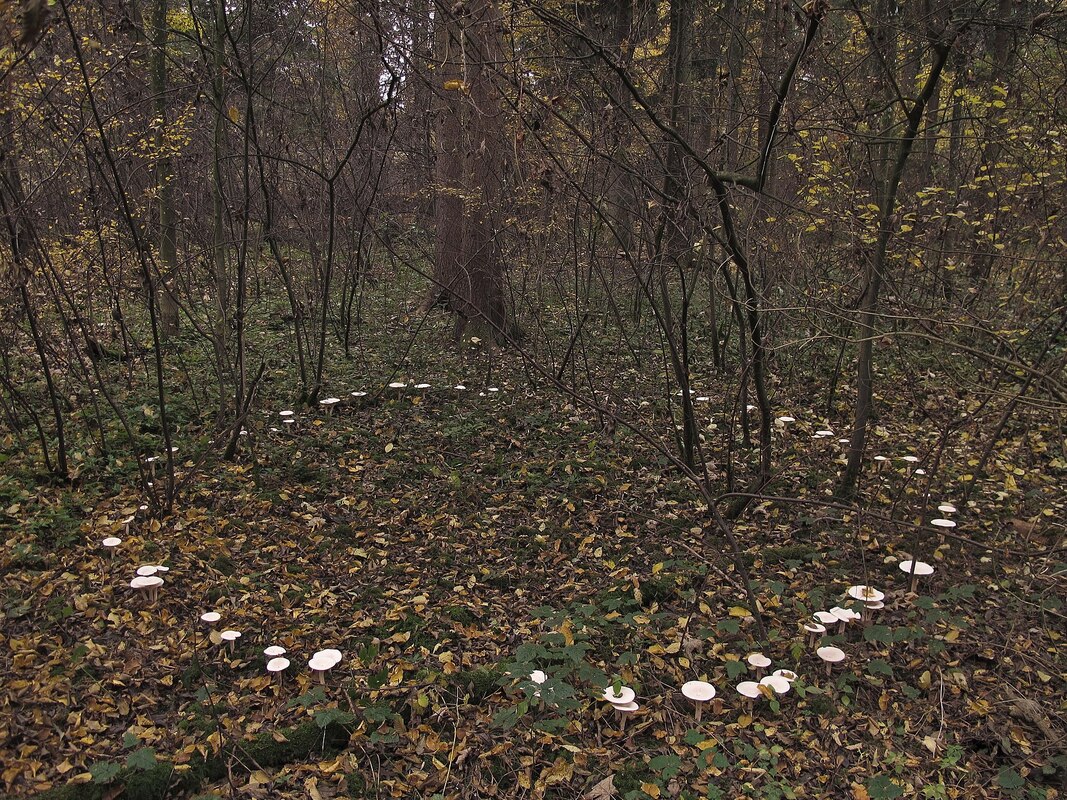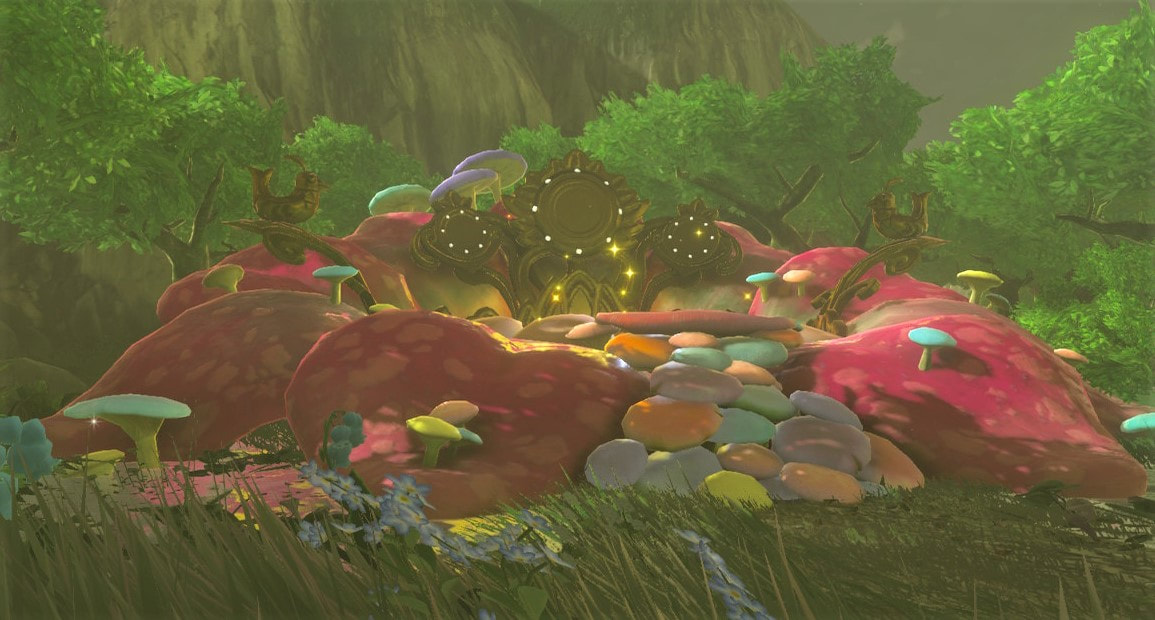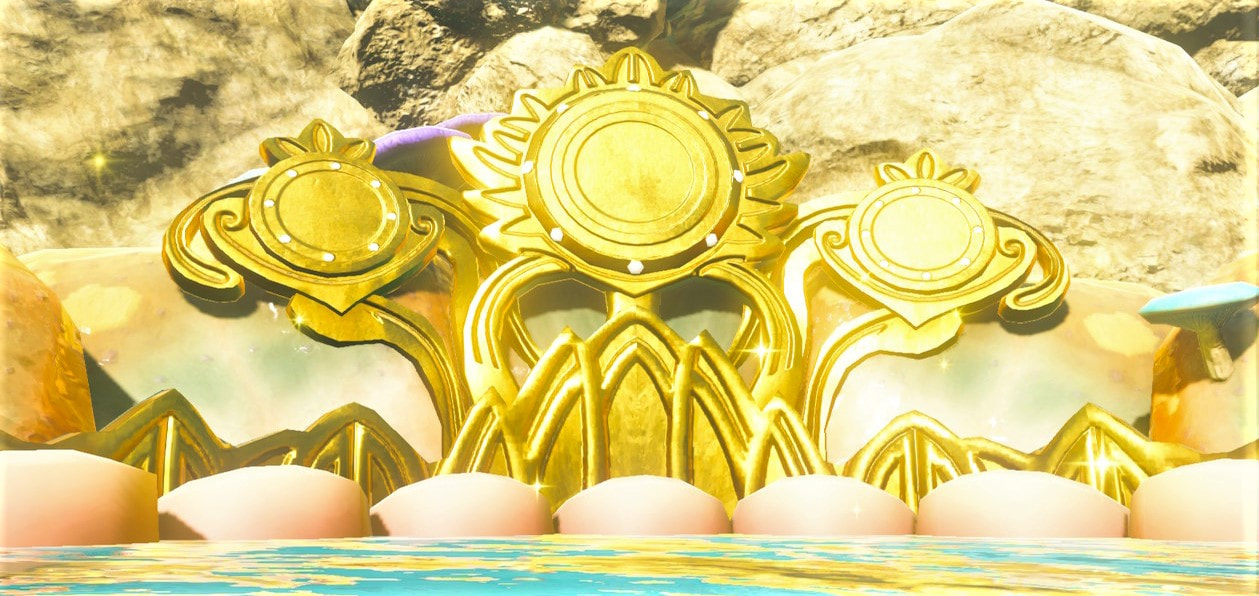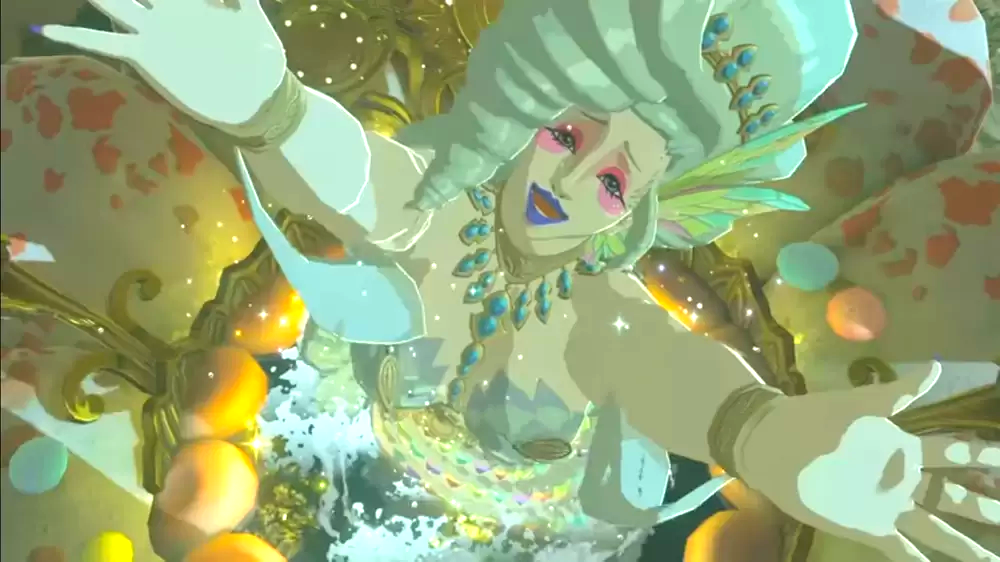Great Fairy Fountains of Hyrule
“Boy . . . Sweet boy . . . Please . . .”
“Aah . . . The power . . . It’s overflowing!!!”
"I have been watching your activities from inside my bud all this time! And haven't you been busy, swinging that sword around.”
— Great Fairies, Breath of the Wild
“Aah . . . The power . . . It’s overflowing!!!”
"I have been watching your activities from inside my bud all this time! And haven't you been busy, swinging that sword around.”
— Great Fairies, Breath of the Wild
Let’s not beat around the bush: an encounter with a Great Fairy is a hypersexual one, no matter how you look at it. They have been repeatedly compared to drag queens in affect and appearance [1], and no one can overlook the (increasingly exorbitant) “fees” — proffered to the outstretched, bejeweled palm of a rather coy mistress [2]— required to even glance at one of these beings. Upon paying, can we look past the pulsating green bud and the sigh of — dare we say? — ecstasy upon being released? But I am getting ahead of myself, and perhaps a bit twitterpated. Let us look at this more clinically.
Link likely stumbles upon the first of the Great Fairy Fountains near Kakariko Village, hearing word of it in the town below, where the Fairy is reported as being the guardian spirit of the community. Famed for her beauty, she is known to bless those that visit her. [3] Unfortunately, as with all her sisters, time has not been kind to their shrines; as the land became full of terrors and travel dangerous, fewer and fewer travelers made pilgrimages to the fountains, and fewer rupees were offered — apparently a source of power for these spirits. [4] When Link first arrives, the shrine is no more than a spiny bud, ancient, sere, and unappealing. Orange thorns contrast starkly with the green sepals, making the whole scene rather foreboding. And this off-putting display seems somewhat counterintuitive; after all, if one is trying to attract more pilgrims, why would one put out vinegar instead of honey? We might read this seeming paradox in a few ways: 1) As a punishment created by the Great Fairies, who would even go so far as to injure themselves for their pride; 2) As a (super-)natural consequence of not receiving worship, which stems simply from the nature of the Fairies and their fountains; 3) An allegory of worth and uselessness; or 4) A comic illustration of an aging . . . well, let’s refrain. Regardless of the impenetrable answer, upon payment the sepals peel back, revealing something quite different — something far more inviting.
Link likely stumbles upon the first of the Great Fairy Fountains near Kakariko Village, hearing word of it in the town below, where the Fairy is reported as being the guardian spirit of the community. Famed for her beauty, she is known to bless those that visit her. [3] Unfortunately, as with all her sisters, time has not been kind to their shrines; as the land became full of terrors and travel dangerous, fewer and fewer travelers made pilgrimages to the fountains, and fewer rupees were offered — apparently a source of power for these spirits. [4] When Link first arrives, the shrine is no more than a spiny bud, ancient, sere, and unappealing. Orange thorns contrast starkly with the green sepals, making the whole scene rather foreboding. And this off-putting display seems somewhat counterintuitive; after all, if one is trying to attract more pilgrims, why would one put out vinegar instead of honey? We might read this seeming paradox in a few ways: 1) As a punishment created by the Great Fairies, who would even go so far as to injure themselves for their pride; 2) As a (super-)natural consequence of not receiving worship, which stems simply from the nature of the Fairies and their fountains; 3) An allegory of worth and uselessness; or 4) A comic illustration of an aging . . . well, let’s refrain. Regardless of the impenetrable answer, upon payment the sepals peel back, revealing something quite different — something far more inviting.
|
Left Image Credit: Wolfgerlion64 for Zelda Wiki.
Above Image Credit of a Sapria Bud: Andreas Fleischmann (Contact: [email protected]), CC BY-SA 3.0 <http://creativecommons.org/licenses/by-sa/3.0/>, via Wikimedia Commons |
Cotera and her sisters [5] each inhabit what must soberly be described as a relative of the corpse flower, family Rafflesiaceae, famed for the largest flowers in the world. More specifically, genus Sapria. Though I am certainly not a botanist by trade (or inclination, though I do love gardening), there are, to my limited knowledge, no other flowers that seem likely inspiration for these fountains. This genus consists of parasitic flowering plants found largely throughout Southeast Asia, though at least one of its species is perfectly at home in the eastern Himalayas. The flowers are “lobed,” not petalled, and spotted blotchily; unlike their kin in Rafflesiaceae, the Sapria have not five but ten or more lobes, similar to the fountains in question. They are unisexual and dioecious, meaning that the female and male organs needed for reproduction are in distinct individuals, not in the same plant. (This tells us something about the needs of these members of Kingdom Plantae, and perhaps something about the Great Fairies.) And goodness, are these flowers — it feels almost like a desecration of the office of flowers to use the same term for something supposedly akin to a daffodil! — endlessly fascinating. First of all, they, like the Great Fairies, are rare. They spend most of their time as small parasitic tendrils creeping along inside their host vines, only becoming visible when it is time to reproduce. The flowers, as intimated by the name, tend to not smell pleasant. Perhaps most intriguingly, the enterprising geneticists have determined that at least one species of this flower has shed 44% of the genes normally at home in other flowering plants. I suppose this shouldn’t come as a surprise in a plant that not only goes about without stem or roots, but without even the ability to photosensitize. (That is shocking.) [6] In all, these unexampled flowers are fitting, at least in their ostentation and eccentricities, as settings for such beings as Hyrule’s Great Fairies.
We should remember that these are not the first Great Fairies to be housed in such floral architecture: in the 3DS version of Ocarina of Time, we saw a fountain inspired by the temples of ancient Egypt, where not only the central fountain but all the torches were cupped within lotus flowers. Further, in the 3DS version of Majora’s Mask, we saw two such settings in the Southern Swamp and at Snowhead. “The Fairy Shrine of the Southern Swamp, carved into the crater-wall of Woodfall, is verdant and green, with an otherworldly sylvan light emanating from the walls. Its columns are of palm trunks and leaves, crowned with lilies, while the cave walls themselves are covered in fine latticework, over which the luminescent, green water flows. Snowhead's Fairy Fountain is lit with a radiant pink, with huge, vertical flower designs upon the walls. In the pool, there are six statuesque, curvilinear pillars — like ornate vases, decorated with ovals, triangles, and diamonds.” [7]
Once each flower blooms, we find a much more inviting scene: a colorful stage of ornate gold metalwork, golden birds, beads like a pearl necklace around the pool, and everywhere mushrooms. They crop up around the fountain, upon the flower’s lobes, and even form the path to the petitioner’s platform. This might seem a strange decorative element for a fairy’s altar, but when we remember the presence of fairy rings in folklore, the choice seems quite appropriate. Fairy rings occupy a delightful space between mycology and mythology: on one hand, they are perfectly explicable, and, on the other, perfectly fey. Mycologically speaking, they are formed when the mycelium of a mushroom sends out an underground series of hyphae — diminutive, threadlike strands — which radiate from the central spore. Mushrooms spring up around this radius, and even after the central mycelium perishes, the ring can continue to grow in size until the radial growths too decay.
Mythologically, fairy rings become perhaps more interesting. Found in folk beliefs all over Europe and in places like the Philippines, people used to believe that the rings were caused by lightning strikes or the dances of elves and fairies. In Germany they were tied to witches’ dancing, and stories about them are especially prevalent in the British Isles. [8] The mystery of fairy rings is not unusual in English literature and mentions can be found in Shakespeare, Drayton, Thomas Hardy, Andrew Lang, and Yeats. Indeed, much of western Europe traditionally seemed to view fairies and their rings with apprehension and caution; in the Thompson Motif-Index of Folk-Literature, there is a taboo (C523.2) against digging in fairy rings, and, generally speaking, one should not disturb a fairy ring in any way, lest one become ensorcelled. [9] And while “references to fungi are not always positive in the English literary tradition, eventually references to mushrooms in the context of fairies assumed a benign context.” [10]
Mythologically, fairy rings become perhaps more interesting. Found in folk beliefs all over Europe and in places like the Philippines, people used to believe that the rings were caused by lightning strikes or the dances of elves and fairies. In Germany they were tied to witches’ dancing, and stories about them are especially prevalent in the British Isles. [8] The mystery of fairy rings is not unusual in English literature and mentions can be found in Shakespeare, Drayton, Thomas Hardy, Andrew Lang, and Yeats. Indeed, much of western Europe traditionally seemed to view fairies and their rings with apprehension and caution; in the Thompson Motif-Index of Folk-Literature, there is a taboo (C523.2) against digging in fairy rings, and, generally speaking, one should not disturb a fairy ring in any way, lest one become ensorcelled. [9] And while “references to fungi are not always positive in the English literary tradition, eventually references to mushrooms in the context of fairies assumed a benign context.” [10]
|
Above Image Credit: James Lindsey at Ecology of Commanster, CC BY-SA 2.5 <https://creativecommons.org/licenses/by-sa/2.5>, via Wikimedia Commons
Right Image Credit: Sporulator at Mushroom Observer, CC BY-SA 3.0 <https://creativecommons.org/licenses/by-sa/3.0>, via Wikimedia Commons |
Two haunting "fairy rings" or "elf circles" upon forest floors.
|
Pastel mushrooms of various sizes enshrine the opened fountain, even forming a pathway to the fairy-pool itself.
But depictions of fairies and their kin are not so easily settled upon, and modernity seems to live with multiple conceptions of fairies. There is the historical version laden with misgivings and mystery, and the much infantilized depiction of fairies and elves which Tolkien so eloquently railed against in his essay “On Fairy-Stories.” When viewed through this second lens, fairies come primarily in a child-friendly “flower-and-butterfly” form which is a “product of ‘rationalization,’ which transformed the glamour of Elfland into mere finesse, and invisibility into a fragility that could hide in a cowslip or shrink behind a blade of grass.” [11] To wit, the mysterious and fey was made knowable and harmless. And, to an extent, this follows as much from primitive human fears as the desire to rationalize and “explain away” things we find discomfiting: humans are particular about the magic we like. Wildness, savagery, and unpredictability are not stomachable qualities for magic, and it doesn’t help that the power of elves and fairies is partly in their ability to “play on the desires of [a man’s] body and his heart.” [12] Which would we prefer: mysterious and powerful beings with intentions all their own and no ken of humanity’s morality, or wee sprites that sit atop mushrooms waiting to frighten children? We seem to have answered our own question, though Tolkien presents a strong response. So too does Hyrule, for in Hyrule, we find beings of a very mixed quality: proud-yet-childish, impotent-yet-powerful, enchanting, repulsive, and fundamentally unknowable. Hyrule’s Great Fairies present elements of both of these representations, alongside aspects particular to Zelda, creating an enticing and memorable incarnation.
Not quite unique to this Zelda depiction is the ostentation of fairies, though the Great Fairies certainly possess a style all their own, which looks to have at least some connection to the rebellious subculture of Japanese gyaru fashion. Some of this flamboyance is transmitted to their regal surroundings, designated most obviously by the diadem-like setting behind the fountain — a tiara of golden birds, flowers, and fruit. A string of candylike beads rests inside of that, much like a pearl necklace, and everything gives off hints of traditional femininity, from color to ornamentation. So, why this vibrancy in such a fallen land? Well, as flowers need pollinators, so too do these fairies need Link; and while they are not (known to be) procreating, which is the end of pollination, they do require Link for their revitalization. So, while a spiny, uninviting bud may not seem lovely enough to attract friendly attention, the splashy, fecund setting which opens out of it provides many cues for the would-be pollinator: the fountains are large, showy, colorful, and likely heady with the perfume of many flowers. It is in this setting that the fairies reside in the midst of their fountains. They dwell beneath the surface of their pools, and in a floral setting, this is precisely where the ovary of the flower would be; thus, while the sexual parts of the flower are missing, each Great Fairy settles into that gap. This may give us a clue as to why the developers chose to make the Great Fairies such hypersexual entities, though it does not excuse their behavior — a fully-willing pollinator Link is not.
But Link does stand to gain from the healing of these fey sisters. Not only are the Great Fairy Fountains oases in a barren, dangerous world, but the fairies themselves are skilled seamstresses, and are able to help protect Link from the elements and the weapons of his enemies. Further, these shrines are home to lazily-floating, restorative pink fairies and many species of plants from blue nightshade to warm safflina. To restore the Great Fairies is to restore not only life to Hyrule, but something else which the kingdom desperately needs — passion.
But Link does stand to gain from the healing of these fey sisters. Not only are the Great Fairy Fountains oases in a barren, dangerous world, but the fairies themselves are skilled seamstresses, and are able to help protect Link from the elements and the weapons of his enemies. Further, these shrines are home to lazily-floating, restorative pink fairies and many species of plants from blue nightshade to warm safflina. To restore the Great Fairies is to restore not only life to Hyrule, but something else which the kingdom desperately needs — passion.
Notes and Works Cited:
[1] As an example, see https://zeldaforelders.com/my-first-great-fairy/ for a lively description of a first encounter with these ladies.
[2] For the mean amounts of 100, 500, 1,000, and10,000 rupees successively! And here we may draw another reference to Andrew Marvell’s famed poem “To His Coy Mistress,” in repeating the lines:
“My vegetable love should grow
Vaster than empires and more slow . . .”
And I dare write no more, for fear of the Censors, but you can continue reading the poem here.
[3] “The Great Fairy Cotera . . . Only a few remain who know this, but this village was built under her watchful eye.” — Impa
“They say up and behind those hills resides Kakariko's guardian spirit. I hear she's incredibly beautiful. I'm too intimidated to go see for myself, though . . . It's said that she offers a special blessing to those that visit her . . . You should go there and see for yourself." — Dorian
[4] “This place was once a beautiful spring . . . But as time passed, fewer and fewer travelers arrived to offer me rupees. As a result, my power has abandoned me. I'm nearly powerless now, so I beg your help. I need rupees to become whole again." — Cotera
Based on the above quote, it seems as though Great Fairies can become powerless over time, though whether this means death or merely impotency is unknown.
[5] At least some of these names are plays on words. Cotera is called “Cotura” in French, like couture, which needs no explanation. Kaysa is phonetically similar to kesa in Japanese, which is a robe worn by Buddhist monks and nuns (though nuns these Fairies are not). From there, the other two names are harder to pin down, unless Tera is playing with the Japanese liquid phoneme for /r/ as an alveolar lateral approximant [l], thus rendering it something like Tela, or cloth, in Spanish — but this is of course absurd. And Mija eludes me entirely.
[6] If you’re really interested:
Cai, et al. (2021). Deeply altered genome architecture in the endoparasitic flowering plant sapria himalayana griff. (Rafflesiaceae). Current Biology 31, 1002–1011. https://doi.org/10.1016/j.cub.2020.12.045
Borah, D., Ghosh, D. (2018). Sapria Himalayana. Resonance 23, 479–489. https://doi.org/10.1007/s12045-018-0637-8
[7] Never cited myself before, but if you’re curious about the other fountains, see here for Fairy Fountains in Ocarina of Time and here for the changes made in Majora’s Mask.
[8] Morgan, A. (1995). Toads and toadstools : the natural history, folklore, and cultural oddities of a strange association. Celestial Arts.
[9] You can access a list here: https://sites.ualberta.ca/~urban/Projects/English/Content/c.htm
Good thing there’s nothing preventing gold digging, eh? (Forgive my joke.)
[10] Dugan, Frank. (2008). Fungi, Folkways and Fairy Tales: Mushrooms & Mildews in Stories, Remedies & Rituals, from Oberon to the Internet. North American Fungi, 3(7): 23-72. https://doi.org/10.2509/naf2008.003.0074
[11] Tolkien, J.R.R. (1947). On fairy-stories. Oxford University Press.
[12] Ibid.
[1] As an example, see https://zeldaforelders.com/my-first-great-fairy/ for a lively description of a first encounter with these ladies.
[2] For the mean amounts of 100, 500, 1,000, and10,000 rupees successively! And here we may draw another reference to Andrew Marvell’s famed poem “To His Coy Mistress,” in repeating the lines:
“My vegetable love should grow
Vaster than empires and more slow . . .”
And I dare write no more, for fear of the Censors, but you can continue reading the poem here.
[3] “The Great Fairy Cotera . . . Only a few remain who know this, but this village was built under her watchful eye.” — Impa
“They say up and behind those hills resides Kakariko's guardian spirit. I hear she's incredibly beautiful. I'm too intimidated to go see for myself, though . . . It's said that she offers a special blessing to those that visit her . . . You should go there and see for yourself." — Dorian
[4] “This place was once a beautiful spring . . . But as time passed, fewer and fewer travelers arrived to offer me rupees. As a result, my power has abandoned me. I'm nearly powerless now, so I beg your help. I need rupees to become whole again." — Cotera
Based on the above quote, it seems as though Great Fairies can become powerless over time, though whether this means death or merely impotency is unknown.
[5] At least some of these names are plays on words. Cotera is called “Cotura” in French, like couture, which needs no explanation. Kaysa is phonetically similar to kesa in Japanese, which is a robe worn by Buddhist monks and nuns (though nuns these Fairies are not). From there, the other two names are harder to pin down, unless Tera is playing with the Japanese liquid phoneme for /r/ as an alveolar lateral approximant [l], thus rendering it something like Tela, or cloth, in Spanish — but this is of course absurd. And Mija eludes me entirely.
[6] If you’re really interested:
Cai, et al. (2021). Deeply altered genome architecture in the endoparasitic flowering plant sapria himalayana griff. (Rafflesiaceae). Current Biology 31, 1002–1011. https://doi.org/10.1016/j.cub.2020.12.045
Borah, D., Ghosh, D. (2018). Sapria Himalayana. Resonance 23, 479–489. https://doi.org/10.1007/s12045-018-0637-8
[7] Never cited myself before, but if you’re curious about the other fountains, see here for Fairy Fountains in Ocarina of Time and here for the changes made in Majora’s Mask.
[8] Morgan, A. (1995). Toads and toadstools : the natural history, folklore, and cultural oddities of a strange association. Celestial Arts.
[9] You can access a list here: https://sites.ualberta.ca/~urban/Projects/English/Content/c.htm
Good thing there’s nothing preventing gold digging, eh? (Forgive my joke.)
[10] Dugan, Frank. (2008). Fungi, Folkways and Fairy Tales: Mushrooms & Mildews in Stories, Remedies & Rituals, from Oberon to the Internet. North American Fungi, 3(7): 23-72. https://doi.org/10.2509/naf2008.003.0074
[11] Tolkien, J.R.R. (1947). On fairy-stories. Oxford University Press.
[12] Ibid.

